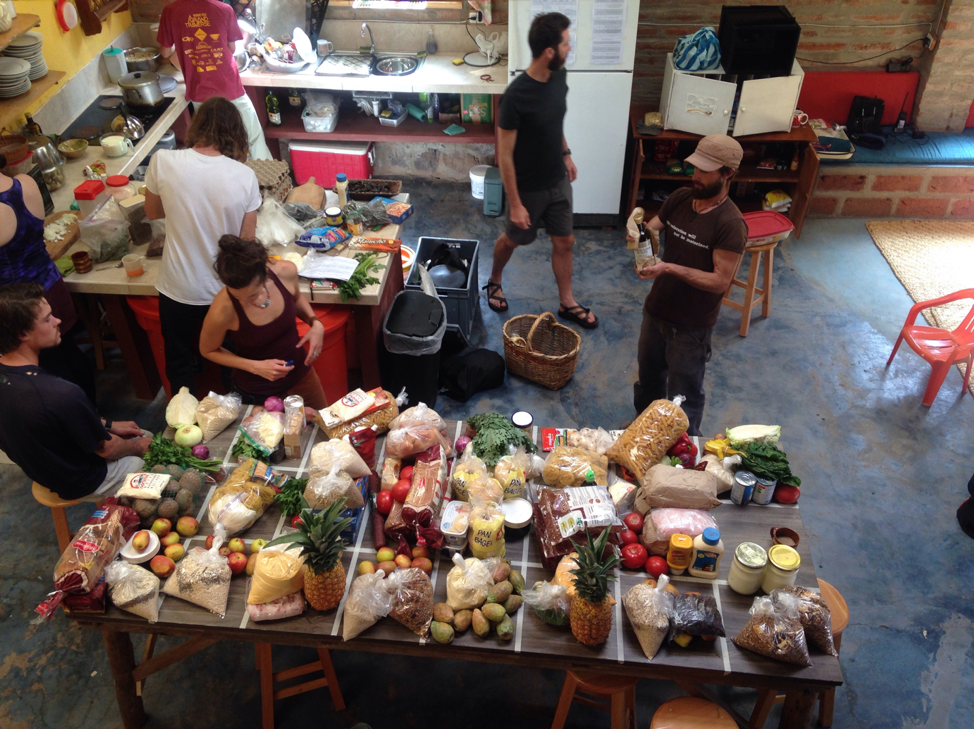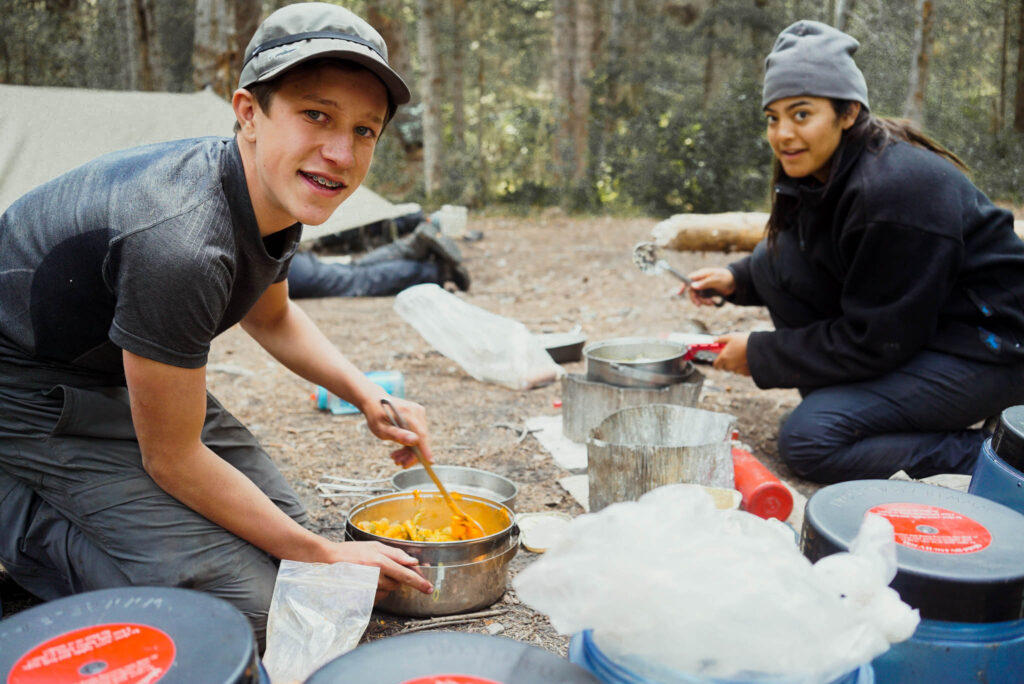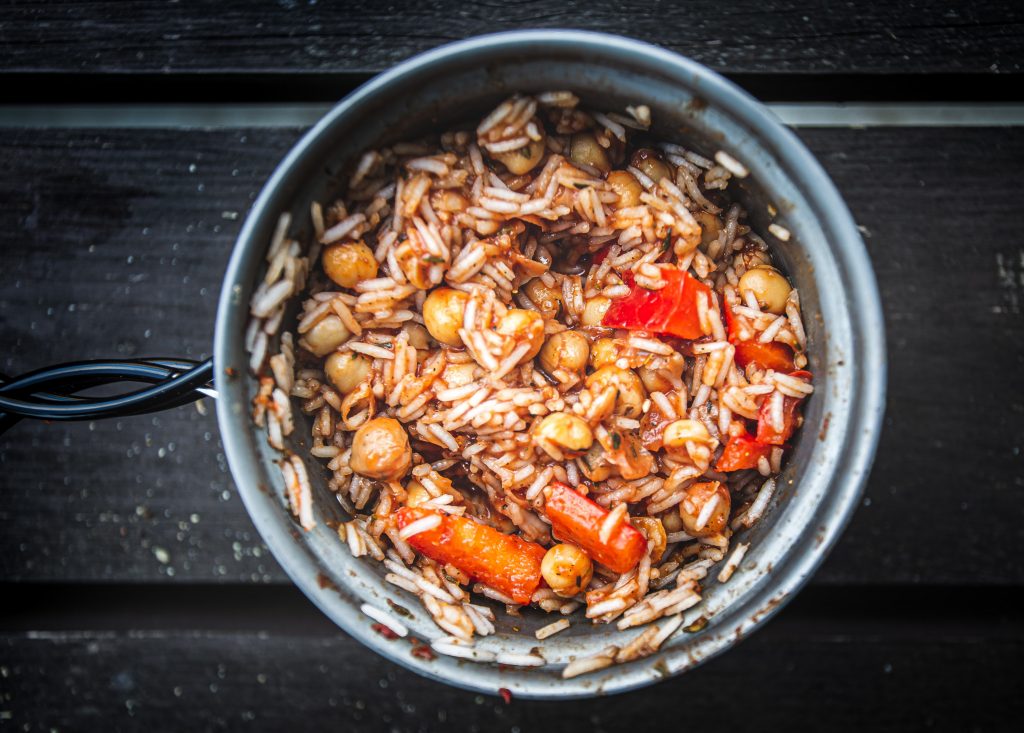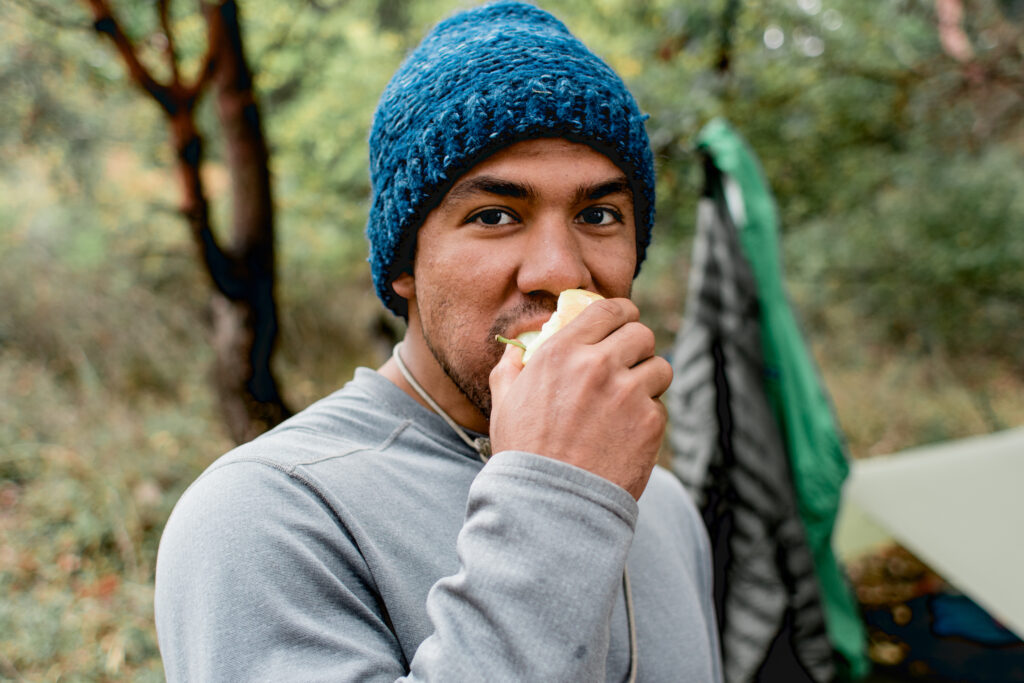Looking for a simple way to pack out vegetarian backcountry meals on an expedition? Packing out food for any outdoor adventure can be a tricky feat of logistics, but it can also be a lot of fun. On Outward Bound expeditions meal-prep is a neat opportunity for students to draw connections between their nutrition and level of physical exertion. Most expeditions lack refrigeration, so eating a meat-free diet is an easy choice.
Planning meals for an expedition requires some prep work, like measuring food according to the number of servings and the number of people on the expedition. One simple way to plan your vegetarian meals is to break down every meal into three components: a grain, a protein and a vegetable and/or fruit. Count up the number of meals you will need for your trip and choose a combination of options from each component that adds up to your total number of meals. You can also use the breakdown below to help you build your backcountry vegetarian meal plan.

A crew of Instructors meal plan and food prep for their backpacking expedition in Ecuador back in 2017. Including harvesting plants, dehydrating snacks and cooking granola. Read the story here. Photo by Annie Holmes.
Vegetarian Proteins
There are plenty of vegetarian proteins to fuel you during your backcountry travel, it’s just a matter of knowing where to look.
- Cheese, Tofu and Tempeh. Tofu and Tempeh are both products made from soybeans. Plan to eat these in the first few days of travel without refrigeration.
- Nut Butter. Peanut butter, sunflower seed butter and other nut butters are great options for almost any meal on trail. Add a scoop to morning oatmeal, eat a spoonful as a protein-filled snack, or mix with soy sauce, warm water, garlic and onion for a sauce to use on top of pasta or rice!
- Textured Vegetable Protein. TVP is a meat substitute that you can rehydrate and add to soup or pasta.
- Hummus Powder. Made from ground chickpeas, use a Tupperware container to start rehydrating hummus powder in the morning to eat in a wrap later in the day.
- Powdered Beans. Powdered beans can be rehydrated to form a bean paste to eat with burritos or lunch wraps. Like hummus, allow for plenty of time to rehydrate.
- Lentils and Dried Beans. Dried legumes are a great protein for a layover day when you can soak then boil them over a stove or fire for a prolonged time. Packing out dried legumes cuts the weight of canned and hydrated beans.
- Powdered Milk. Powdered milk can be mixed into oatmeal or other breakfast grains.
- Nuts and Seeds. Plan for snacks that are protein-rich with trail mixes based on nuts and seeds such as peanuts, walnuts, almonds and cashews, as well as sunflower seeds or pumpkin seeds. Packing nuts and seeds in bulk allow you to add extra protein to any meal.

Mix the cheese with powdered milk and noodles and what do you have? A classic backcountry vegetarian meal. Photo by Brooke Warren
Grains
A great way to boost your meals while on an expedition is to think of the grains you like to have on an everyday basis. Consider these grains below which can be great to accompany your choice of protein.
- Pasta. Consider gluten-free legume-based pasta such as black bean or lentil noodles for extra protein.
- Quinoa and Farro. These are two less- common grains that contain protein, and are great fuel for expedition travel. You can eat them with any dish and they are great substitutes for rice.
- Oats. Packing bulk quick oats provides plenty of options for breakfast. For a quick meal before hitting the trail, just add hot water and some dried fruit and nuts.
- Flour. Bread baking can be magical on an expedition, and packing bulk flour allows you to cut weight and make the dough out on the trail. For a versatile dough, make a mixture of white flour, whole wheat flour, baking soda, baking powder, salt and dried milk. This mixture can be used to make anything from biscuits to pancakes!
- Rice. Packing brown rice will give longer-lasting energy and is a great staple. Use a Tupperware container to pack up leftovers for lunch the following day.

A mix of rice, chickpeas and peppers can help replenish your body with the nutrients and energy you need after a long day of exertion. Photo by Marel Piwnicki.
Vegetables and Fruits
- Fresh Fruit. It’s always exciting to have fresh fruit on an expedition. Since it’s bulky and heavy, it’s a good idea to consume this first. Some good choices for packing that won’t squish too easily include apples and oranges.
- Fresh Veggies. Packing onions and carrots will make a great addition to most meals. Cabbage is also a veggie that doesn’t go bad easily and can be used to make lunch wraps!
- Dehydrated Fruit. Raisins are a great staple for iron, and other dried fruits such as dried apricots, dates, and prunes provide good fiber. Dried pineapple and dried banana chips are great as sweet treats.
- Dehydrated Vegetables. You can use a dehydrator to dehydrate vegetables, at home and create dehydrated vegetable mixtures to add to soups and stews. Such as dehydrated mushrooms for a mushroom soup base.
- Tomato Paste. Compact and flavorful, tomato paste in a small aluminum can (not glass!) can be added to many meals.

Apples and oranges are often included in the meal plan for expedition lunches. Photo by Charis Nichols.
Extras
- Spice Kit. Packing a small spice kit for backcountry travel can make a big difference. Great staples include salt, pepper, cinnamon, oregano and curry powder. Also, consider chili powder or a small plastic bottle of hot sauce. Bringing a clove or two of garlic and a ginger root can be great additions.
- Sweets. Consider packing out some of your favorite sweeteners that can be added to a variety of meals, such as brown sugar. Sticky syrups like honey tend to get messy but might be worth it!
- Desserts. Pudding powder is a great lightweight dessert. An easy apple crisp can be made by rehydrating dried apples and topping with oats, brown sugar, nuts and oil topping, or try out this Candied Apricot Coffee Cake.
- Oils and Sauces. Use plastic screw-top Nalgene bottles for a clean way to pack out a few condiments such as oils and soy sauce.
- High/low Bar. A fun treat on an expedition is to bring a favorite treat to save in your pack and only pull out at your highest high moment or lowest low of the expedition.

Pudding powder never goes to waste on an Outward Bound expedition. Photo by Stu Montgomery.
Packing Out Food
- When packing out food, use scotch tape and a permanent marker to label each item with what is packed, and the number of servings the amount is intended for. This will help you ration out how much you use along the way.
- Remove any stickers or excess packaging at home so that you’re not left carrying it on the trail.
- If you’re packing for a group or for a long excursion, use cloth bags to help organize food and make it easy to find what you’re looking for.
- Use extra plastic bags to pack out all compost and trash that you generate, in accordance with Leave No Trace, and be sure to store your food out of reach of critters, according to the practices in the area where you’re journeying.
- At the end of an expedition, it’s helpful to make note of what foods are leftover and what you were wishing for more of. As you take off on your next expedition, you can begin to hone the details of your food-packing approach!
Creating nutrition-packed vegetarian backcountry meals isn’t difficult, it just takes a little organizing, categorizing and planning! Get outside and let us know what meals you string together from this list by leaving a comment below.
About the Author
Nora Spicer has instructed backpacking and canoeing courses at the Hurricane Island Outward Bound School since 2014. She has an MA in Environmental History from Harvard University and teaches Place-based US History (honoraspicer.com).




